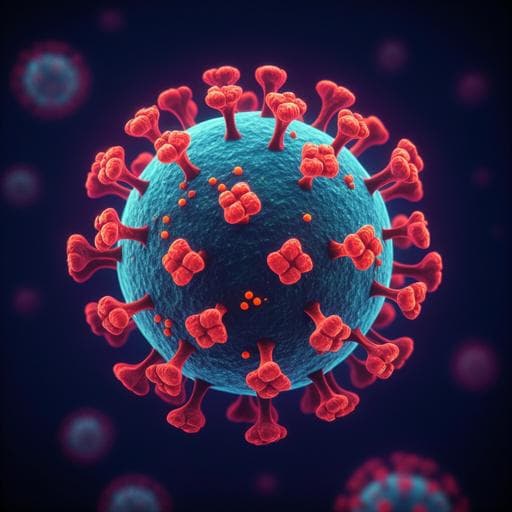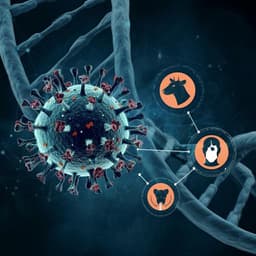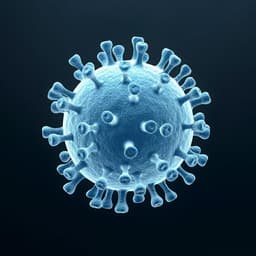
Veterinary Science
Adaptation, spread and transmission of SARS-CoV-2 in farmed minks and associated humans in the Netherlands
L. Lu, R. S. Sikkema, et al.
In this groundbreaking study, researchers, including Lu Lu and Marion P. G. Koopmans, unveil the intricate web of SARS-CoV-2 transmission dynamics between minks and humans on farms during the initial pandemic wave. Discover how genomic sequencing and innovative phylodynamic methods reveal significant virus spread, highlighting the importance of genetic and epidemiological insights in understanding outbreaks at the animal-human interface.
~3 min • Beginner • English
Introduction
The study addresses how SARS-CoV-2 transmits within and between farmed mink populations and associated humans, and the potential for spillover to the community. In early 2020, multiple animal species, particularly carnivores, were noted as susceptible to SARS-CoV-2. In the Netherlands, SARS-CoV-2 was first detected in farmed minks in late April 2020 with respiratory signs and increased mortality. Initial One Health investigations showed five distinct mink clusters reflecting independent human-to-mink introductions and provided evidence for mink-to-human transmission on farms. By November 2020, 68 of 126 mink farms were infected; the modes of farm-to-farm transmission remained largely unknown. The study’s purpose was to use whole-genome sequencing and Bayesian phylodynamics to elucidate introduction timing, farm-to-farm transmission networks, the evolutionary and spatial dynamics of mink clusters relative to human SARS-CoV-2, identify potential predictors of between-farm spread, and assess spillover to nearby communities.
Literature Review
Background highlights include: evidence of SARS-CoV-2 susceptibility in various carnivores in contact with infected humans and multiple international reports of SARS-CoV-2 in farmed minks. Prior Dutch investigations (April–June 2020) identified five mink clusters derived from human-circulating lineages and documented mink-to-human transmission among farm personnel. Comparative context includes Denmark’s Cluster V mink variant associated with community spread and specific Spike substitutions (e.g., Y453F) reported to affect ACE2 affinity and antibody binding. Broader literature indicates extensive SARS-CoV-2 lineage diversity in humans, typical evolutionary rates for coronaviruses, and known spatial drivers of farm-to-farm spread for other pathogens. This study builds on these by providing detailed phylodynamic and transmission analyses across a national mink epizootic.
Methodology
Study design: One Health molecular epidemiological investigation combining WGS of mink and human samples linked to mink farms with epidemiological metadata and Bayesian phylodynamic analyses.
Sampling and diagnostics:
- Mink farms suspected of SARS-CoV-2 were visited for statutory sampling by NVWA; non-random throat and rectal swabs from 20 clinically affected minks were collected. Triggers included owner-reported increased mortality/respiratory signs or positive surveillance signals.
- Surveillance included an Early Warning System (weekly RT-PCR on carcass nasopharyngeal swabs; up to five increased to 50 by end of August) and two mandatory serological screenings (end of May and September 2020; 60 animals per farm) using in-house ELISAs (RBD, confirmation with S1).
- Human testing of owners and employees on infected farms followed national policy; on the first 16 farms, active case finding and serum collection were done; thereafter symptomatic testing at regional facilities; no sera taken on later farms.
- Community screening: two rounds of anonymized human sample selection from the same four-digit postal code regions as infected farms (March–April, and Oct–Nov 2020), plus samples collected up to Jan 4, 2021.
- Diagnostics: RT-PCR on mink oropharyngeal/rectal and human upper respiratory samples. RT-PCR positive samples with Ct<32 (up to five per farm) were selected for WGS.
Sequencing and bioinformatics:
- Reads mapped to NC_045512.2 with minimap2; consensus built via pysam; ends trimmed (first/last 30 nt); homopolymer regions manually checked; sites with <30x coverage masked as N.
- Alignment: MAFFT; partitioned into coding and intergenic; final length 29,508 nt. ML trees: IQ-TREE (HKY+G4, 1000 bootstraps). Temporal signal assessed with TempEst.
Data included:
- Full genomes from minks and humans linked to mink farms (64/68 farms yielded 295 mink genomes; 57 human genomes from 27 farms). Background: representative human genomes from the Netherlands (GISAID; up to Jan 4, 2021), subsampled to at least one per Pango lineage per region per week.
Phylodynamics and phylogeography:
- Time-resolved analyses with BEAST 1.10.4. For full dataset: uncorrelated relaxed clock (mean rate estimate). For individual clusters (A, C, D): strict clock with prior mean 1e-3 (95% HPD 6e-4 to 2e-3). Demography: Skygrid for effective population size (Ne). Transmission potential: BDSKY in BEAST2 v2.6.3 to estimate Re over five time intervals; priors included Re mean 2.5 (95% HPD 0.6–6), becomeUninfectiousRate reflecting time to culling (mean 26, equivalent to ~14 days; 95% HPD 5–20 days), sampling proportion mean 2e-4 (95% HPD 1e-5–1e-3), and origin times informed by TMRCAs.
- Spatial diffusion: continuous phylogeography (relaxed random walk) in BEAST 1.10.4; validated with GEO-SPHERE in BEAST2.
- Discrete trait analyses: host (mink/human), farm ID, province, Spike substitutions (L452M, Y453F, F486L, N501T) and their combinations mapped on time-scaled trees; transitions inferred via asymmetric models with BSSVS; Markov rewards used to estimate expected number of host/farm jumps.
Predictor analysis (GLM):
- Generalized linear model within discrete trait phylogeography to assess predictors of between-farm transmission rates. Predictors tested (after removing highly correlated ones) included: inter-farm distance, personnel links (shared owners/employees/family/technicians/social links), shared feed supplier, veterinary service provider, mink population sizes (origin/destination), number of sequences per farm (origin/destination), municipal human population density (origin/destination), and days from sampling to culling (origin/destination).
Statistics and tests:
- Mann–Whitney U tests assessed associations of Spike substitutions with host/farm/location. BSSVS used Bayes Factors to identify statistically supported transmission links (BF>3 considered). HPD intervals reported for key parameters.
Ethics: Outbreak investigations under Public Health Act; no separate medical ethical clearance required.
Key Findings
- Scale and timing: 68/126 (54%) mink farms infected between 24 April and 4 November 2020; most in North Brabant (n=43) and Limburg (n=23). Infected farms were culled within 0–6 days after sampling (mean 2, median 1) from NB8 onwards.
- Human infections on farms: 41/68 farms had RT-PCR–confirmed human infections; on 31/41 farms human positives were sampled after mink detection; in 3/8 farms with early positives, workers tested >1 week before animal detection.
- Sequencing: 295 mink genomes from 64 farms; 57 human genomes from 27 farms; 673 background human genomes used. Five mink clusters (A–E) derived from Pango lineages B.1.8 (A), B.11 (B,D), B.1.22 (C), B.1.5 (E).
- Cluster dynamics: Cluster A (195 sequences; ~60% of infected farms, n=40) spread across 15 municipalities (April–November). Cluster C involved 15 farms (late May–early Sept). Cluster D involved eight farms (late May–early Aug). Clusters B and E were confined to single farms (NB2, NB11). One farm (NB8) had two clusters (A and D).
- Introduction timing and rates: Human-to-mink introductions occurred mid-March (A, B, C) to late April (D, E). Overall mean evolutionary rate 7.9×10^-4 subst/site/year (95% HPD 7.2×10^-4–8.4×10^-4). Cluster A had a higher rate 1.41×10^-3 (95% HPD 1.2×10^-3–1.75×10^-3) subst/site/year.
- Spatial diffusion: Mean diffusion rates: Cluster A 147 km/year (95% HPD 131–162), Cluster C 91 (70–111), Cluster D 83 (48–122) km/year.
- Population dynamics and Re: Cluster A Ne expanded in late March; Re >1 from start of infections, dipped after May, increased to median ~1.6 (95% HPD 1.2–2.1) in early August, then ~1.3 (0.8–1.7) from late Sept to Nov. Cluster C Re dropped below 1 after May then rose to ~1.5 (1.0–2.3) from late July. Cluster D estimates had wider uncertainty.
- Spike mutations: Four RBD-contact substitutions observed within mink clusters:
• F486L in 217 sequences from 40 farms, clusters A and C (67% of all sequences; 68% within-cluster sequences), appearing late April and becoming dominant from mid-August (A) and from June (C).
• Y453F in 37 sequences from 10 farms across clusters A, D, E (3%, 82%, and 100% within-cluster, respectively), appearing end April–early July.
• L452M in 44 sequences from nine farms (all in Cluster C; 59%), July–September.
• N501T in four sequences from three farms (clusters A, C, D), late April–end May.
Deletions Del141–143 and Del141–144 in Spike were identified in two Dutch mink genomes. No 69–70 deletion detected.
- Transmission counts: Estimated at least 43 mink-to-human transmissions (95% HPD 34–50) across multiple farms (Cluster A: 27 transmissions in 13 farms; Cluster C: 10 in seven farms; Cluster D: six in three farms). Evidence of bidirectional transmission between minks and humans and between farms, sometimes mediated by personnel links.
- Spillover to community: Three human cases with mink-related strains detected (Clusters A or C), including two in provinces without infected mink farms and with no reported links to mink sector; limited onward community transmission; one escaped mink tested positive (Cluster A).
- Predictors of between-farm spread (Cluster A GLM):
• Distance between farms negatively associated with transmission (coefficient −0.63; 95% HPD −0.90 to −0.41; inclusion prob. 0.99).
• Personnel links positively associated (coefficient 1.30; 95% HPD 0.51 to 2.11; inclusion prob. 0.97).
• Feed supplier, veterinarian, farm sizes, sample sizes, human density, and days to culling were not significant.
- Control measures and outcomes: Implementation of transport bans, hygiene protocols, surveillance (EWS, serology), and culling from June; last infected farm detected Nov 4, 2020; no new infections thereafter; fur farming banned from Jan 2021.
Discussion
Findings demonstrate multiple independent human-to-mink introductions that seeded distinct clusters, with three clusters (A, C, D) sustaining farm-to-farm transmission over months. Cluster A exhibited faster evolution, broader spatial diffusion, and prolonged spread compared to other clusters. The emergence and subsequent dominance of Spike RBD substitutions (notably F486L, and also L452M, Y453F, N501T) coincided temporally with increases in Re after summer 2020, suggesting potential adaptation to mink and increased transmissibility, although causality requires laboratory confirmation. Transmission networks inferred from genomic data and epidemiology highlight personnel links as a key driver of farm-to-farm spread, while geographic proximity also played a role; long-distance transmission events aligned with shared personnel. Despite frequent mink–human transmission among farm-associated individuals, community spillover was rare and did not lead to sustained spread. Continuous genomic surveillance at the human–animal interface is essential to detect adaptive changes and manage risks of animal reservoirs contributing to SARS-CoV-2 evolution, particularly as human vaccination increases and mink farming practices and biosecurity vary across countries.
Conclusion
This study integrates genomic and epidemiological data to elucidate SARS-CoV-2 adaptation and transmission dynamics in Dutch mink farms and associated humans. It identifies multiple introductions, extensive within-sector spread driven by personnel links, limited community spillover, and the emergence of mink-associated Spike substitutions accompanying increased phylodynamic growth. Key contributions include quantifying mink-to-human transmission events, mapping farm-to-farm transmission networks, and identifying significant predictors of spread. Future work should include experimental assessment of the phenotypic effects of identified mutations on fitness, transmissibility, and antigenicity in mink and humans; improved capture of mobile/temporary workforce data to refine transmission models; sustained One Health surveillance in susceptible animal populations; and evaluation of biosecurity and vaccination strategies to prevent reservoir establishment and spillback.
Limitations
- Sampling bias and incompleteness: Not all infected farms yielded genomes (4/68 lacked genomes) and only 57/102 human positives linked to farms were sequenced, leading to potential unsampled transmission links and biased trait/GLM inferences.
- Uncertainty in phylodynamic estimates for smaller clusters (C and D) with wider HPD intervals for Ne and Re.
- Difficulty identifying and sampling unregistered or mobile workers may underestimate human-mediated transmission contributions.
- Non-random mink sampling (targeting clinically affected animals) could bias within-farm diversity estimates.
- GLM predictor analysis limited by available metadata and potential residual confounding; significant predictors identified for Cluster A did not generalize to Clusters C and D.
- Causality between Spike substitutions and increased transmissibility is not proven; functional validation is needed.
Related Publications
Explore these studies to deepen your understanding of the subject.







